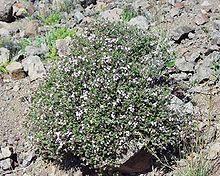Thymus (plant)
| Thymus | |
|---|---|
 |
|
| Thymus vulgaris | |
| Scientific classification | |
| Kingdom: | Plantae |
| (unranked): | Angiosperms |
| (unranked): | Eudicots |
| (unranked): | Asterids |
| Order: | Lamiales |
| Family: | Lamiaceae |
| Genus: |
Thymus L. |
| Type species | |
|
Thymus vulgaris L. |
|
| Synonyms | |
|
|
The genus Thymus (/ˈtaɪməs/;thymes) contains about 350 species of aromatic perennial herbaceous plants and subshrubs to 40 cm tall in the family Lamiaceae, native to temperate regions in Europe, North Africa and Asia.
Stems tend to be narrow or even wiry; leaves are evergreen in most species, arranged in opposite pairs, oval, entire, and small, 4–20 mm long, and usually aromatic. Thyme Flowers are in dense terminal heads, with an uneven calyx, with the upper lip three-lobed, yellow, white or purple.
Several members of the genus are cultivated as culinary herbs or ornamentals, when they are also called thyme after its best-known species, Thymus vulgaris or common thyme.
Thymus species are used as food plants by the larvae of some Lepidoptera (butterfly and moth) insect species, including Chionodes distinctella and the Coleophora case-bearers C. lixella, C. niveicostella, C. serpylletorum and C. struella (the latter three feed exclusively on Thymus).
There has been a considerable amount of confusion in the naming of thymes. Many nurseries use common names rather than the binomial name, which can lead to confusion. For example golden thyme, lemon thyme and creeping thyme can all refer to more than one cultivar. There is some confusion over the naming and taxonomy of some species, and Margaret Easter (who holds the NCCPG National Plant Collection of thymes in the UK) has compiled a list of synonyms for cultivated species and cultivars.
...
Wikipedia
